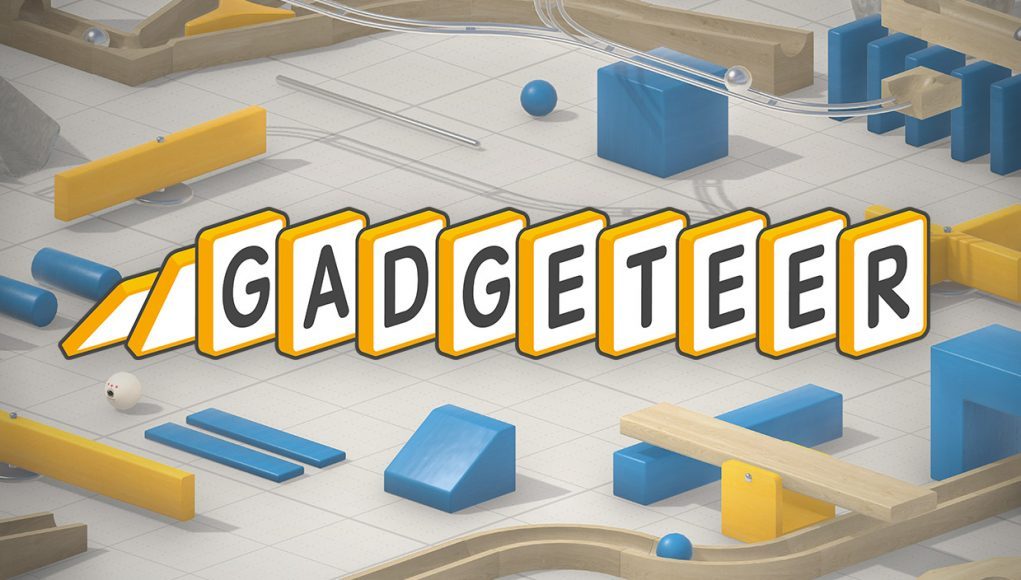In all the time I’ve spent mucking around in Oculus Home and Rec Room—both physics-based sandbox environments that promise to let me do as I please in VR—I always felt like there was a significant time gap involved with creating anything of mechanical or creative depth. Now that Rube Goldberg machine sim Gadgeteer is available, I find myself enthralled both by its extreme simplicity and the perpetual bounty of possibilities laden within its endless supply of stackable knick-knacks and useful doodads.
Gadgeteer Details:
Developer: Metanaut
Available On: Steam, Oculus (Rift)
Reviewed On: Rift
Early Access Release Date: April 23rd, 2019
Note: This game is in Early Access which means the developers have deemed it incomplete and likely to see changes over time. This review is an assessment of the game only at its current Early Access state and will not receive a numerical score.
Gameplay
Gadgeteer is split between two primary modes: ‘Sandbox’ mode and ‘Puzzle’ (campaign) mode. It also comes with a short tutorial that runs you through the four tools that you’ll use to grab, clone, delete, and freeze objects with your dominant hand.
Physics are central to everything that happens in this game, which makes important the question: ‘are the physics good?’ To frame my answer to this question, after playing for 14 hours—nine of them in ‘Puzzle’ mode and five of them in ‘Sandbox’ mode—I’d like to point out that I’ve constructed an actual Rube Goldberg-style reaction machine exactly once in my life. That machine, which I designed for an 8th grade science project, consisted of a basketball, a ruler, a few dominoes, and a book. Long story short, it wasn’t all that impressive. But if I’d owned Gadgeteer at the time, I’d have felt perfectly comfortable blueprinting a much more elaborate contraption inside of the game and then proceeding to reproduce it at a perfect 1-1 scale in the real world. That is to say: yes, the physics are good. But not without a minor fault (explained in the ‘Immersion’ section below).
The ‘Sandbox’ mode is a true sandbox in every respect. As soon as you enter it, you’re granted unlimited access to all 50+ parts—an infinite treasure trove brimming with various shapes and sizes of dominos, marbles, balls, levers, hinges, and marble tracks. You also get the run of the entire multi-room apartment environment, which is normally cordoned off in the campaign mode until each room is unlocked.
If I were feeling uninspired in Sandbox mode, I could load up one of various prebuilt contraptions for reference, such as a pinball machine or a domino T-Rex. I found it nifty to dissect and play with a developer’s completed work, an exercise which gave me ideas for my own devices. That said, I can see other players spending innumerable hours coming up with increasingly complex systems—but I also found solitude in hanging out, poking the game’s physics systems, and playing my own impromptu version of Jenga with my infinite supply of dominoes.
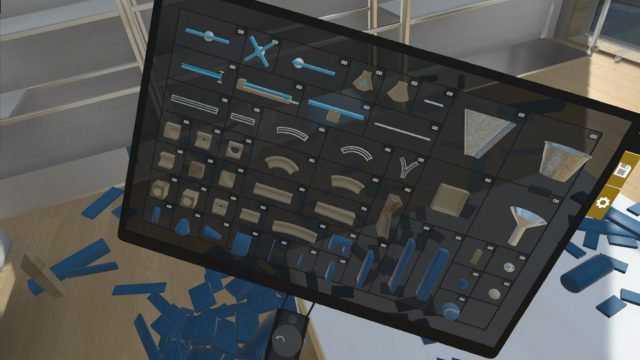
The ‘Puzzle’ campaign mode, on the other hand, offers a set of 60 puzzles that take you from one end of the apartment to the other as you slowly power on the ‘machine’ in the center of the room. Each puzzle only grants you a limited selection of parts to play with, and you complete one by either landing a domino or rolling a marble (or marbles) into the goal chamber at the end, which fills up a green power line leading to the beginning of the next puzzle.
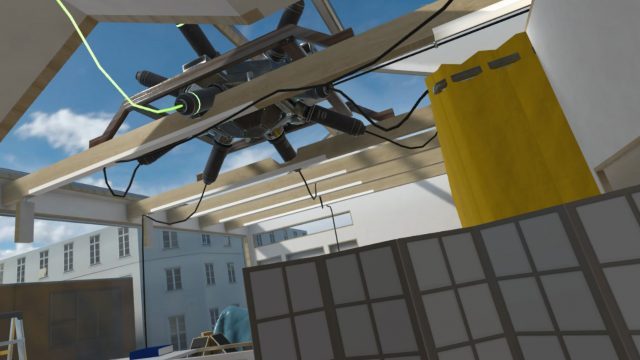
Beating a puzzle also rewards you with a burst of confetti and a celebratory jingle; a little dopamine release that keeps the momentum going as you progress from one scenario to the next. In the later levels, victory brings an especially welcome sense of relief after you’ve spent upwards of 30–40 minutes improvising something that feels like it could totally fall apart and fail at any time. This is to say that, in fact, the physics in Gadgeteer are not deterministic. It’s supremely satisfying to come up with an idea for a machine, iterate on it until each segment is perfect, and then watch as the chain reaction go off exactly the way you want it to. There’s always a chance that something won’t work completely right; a domino might fall in the wrong direction or a marble won’t land hard enough, making part of the challenge of building the ‘best’ machine a matter of tightening your design for the best probable outcome.
But each puzzle is, ultimately, just a very well-designed gimmick that’s intended to teach you how to manipulate a certain set of tools within Gadgeteer’s physics sandbox.
Whose apartment you’re busy making a mess of, as well as the purpose and origin of the mysterious machine in the middle of the room, are not explained in any way until the very end of the campaign. As a matter of fact, the only story in the game is during the big reveal at the end. Thinking back to how some developers like to sprinkle story throughout their worlds in clever nooks and crannies, I haphazardly triple-checked the entire apartment area for environmental story cues scattered throughout. Either I’m terribly inept at finding story bytes, or environmental storytelling simply doesn’t exist here; a missed opportunity for the time spent mulling around and trying to stick dominoes behind random household objects. If you are curious what the story is, you can find it much faster by skimming the game’s official description which talks about “the mystery behind the disappearance of a brilliant mad scientist and her daughter.”
Immersion
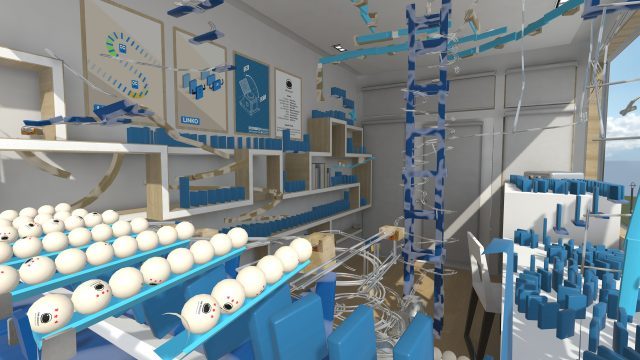
While storytelling can no doubt enhance immersion, the lack thereof doesn’t siphon enjoyment from the core experience of stacking blocks and building widgets in Gadgeteer. Aside from a glitch that occurs when colliders get caught on one another (which happens semi-frequently when you push things like metal marble tracks too closely together at odd angles), the physics of Gadgeteer in its early access state are almost exemplary. Though that issue would be less evident if there were a ‘snap’ function that allowed me to quickly align objects before sticking them together. Otherwise, I’m particularly impressed by how many objects I can have interacting with one another synchronously without my computer (an i7 6700K, GTX 1070, and 16GB of RAM smacked into a desktop box) showing much or any visible stress. Note that this is while playing with the game’s second highest graphical preset.
During my five hours in ‘Sandbox’ mode, I tried and mostly failed to break the physics system by throwing lots and lots of dominos at one another. I completely lost count of how many were in my virtual room at peak time, but it was certainly more than anybody in a real room would know what to do with. My framerate did end up eventually taking a hit, though that was expected. What I feel is impressive and worth pointing out, is that (while the framerate was severely dropping) the pile of virtual objects still appeared to behave and react like real objects when I pushed another domino through them to open a path.
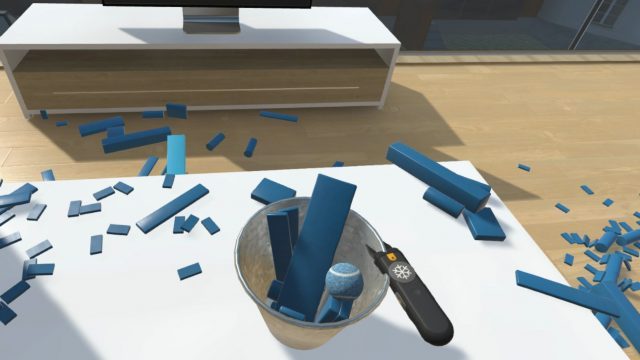
Moving away from the physics for a moment, I’d like to compliment developer Metanaut for how polished and clean everything looks—regardless of the graphical preset, the environment is small and there are only a few different types of objects being rendered at any given time. Thus, Gadgeteer is able to make each item look like its real-world equivalent without demanding too many system resources. During my playthrough, this resulted in a much deeper experience that sold me on the machines I was building, as if they were ‘real’ contraptions that I’d put together in my own bedroom.
The soundtrack didn’t do much for me. It’s just a handful of guitar riffs that alternate based on whether you’re building a machine or whether you’re sequencing a chain reaction. I opted turned the in-game music off and played music from my own playlist (in my case, an entire Spotify playlist full of Japanese hip hop), which immediately made the experience more enjoyable.
Comfort
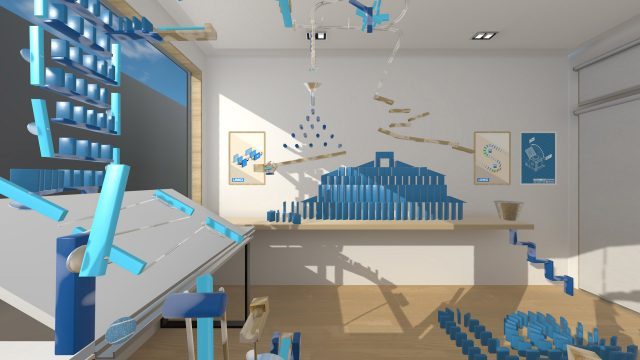
Unless you’re using an Oculus Rift (or Rift S, presumably), there aren’t any options to switch to something other than the ‘grab and pull’ style of artificial locomotion that Gadgeteer natively uses. For non-Oculus users, you can’t use thumbsticks for smooth or snap-turning either. Instead, you need to twist your wrist (or wrists, if two-handed turns are enabled) while you’re grabbing the world. This may bother those who play in smaller rooms and rely more on artificial locomotion to get a better angle of their workspace. It is worth noting, however, that Metanaut has recently added options to turn off the forced-on comfort blinders and the one-handed snap-turns that both made locomotion feel downright choppy when Gadgeteer first launched in early access.
It’s also worth noting that Gadgeteer will never present you with an urgent need to move from place to place. Most of the time, you’ll use artificial locomotion to center yourself in your play area so you can naturally walk and peer around your contraption while you work. Because I could just grab the world to move my position however I wanted, I never found myself craning my head too hard or making myself uncomfortable. I did, at certain points, find myself subconsciously sitting or kneeling down to tweak a machine section to perfection. At that point, the locomotion system had become so second nature to me that I didn’t realize I’d spun the world around and brought everything down to eye level until I consciously made a note of it.
Conclusion
In its early access state, Gadgeteer is both a fantastic Rube Goldberg-style reaction machine builder and, at its most gripping moments, a true example of VR Presence—where the act of building and testing a machine becomes so engaging that you forget you’re playing with code instead of physical toy dominos. The collider occlusion bug within the physics system should still be addressed, and continued improvements toward the locomotion system would be nice. But, content-wise, Gadgeteer is already a complete package out of the box. At $15, I consider it a steal.
Note: This game is in Early Access which means the developers have deemed it incomplete and likely to see changes over time. This review is an assessment of the game only at its current Early Access state and will not receive a numerical score.

